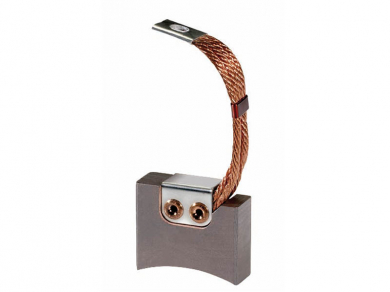-
MERSEN global
-
- Contact Us
- Electrical Protection & Control
- Solutions for Power Management
- Anticorrosion Equipment
- Graphite Specialties
- Power Transfer Technologies
Carbon brushes for wound-rotor motors (slip ring rotor motors)
Asynchronous motor brushes
Mersen's metal-graphite and electrographite brushes are suited for wound-rotor motors (slip ring rotor), which are increasingly used, especially in process industry.
Mersen offers a wide range of brush grades, of electrographite and metal graphite type, such as CG677, to cover all operating conditions of asynchronous motors with wound rotor.
Electrographitic grades are prepared from carbon powders and a specific binder; they are then subject to high temperature thermal treatments (>2500 °C) to transform the basic amorphous carbon into artificial graphite, and enhance the physical properties of the grades.
Metal graphite brushes grades are prepared according to 2 possible processes:
- from electrographite treated by metal impregnation (copper, silver), providing a high solidity and high load capacity,
- from a mix of powdered purified natural graphite and metal powders (copper, silver…), which are then pressed and baked to bring them to the required solidity and cohesion levels.
Mersen’s Research & Development Department continuously develops brush materials to improve the current carrying capacity and lifetime of the carbon brush and reduce slip ring maintenance.
The choice of the most suited grade depends on a large number of parameters linked to the asynchronous motor itself as well as its environment, such as: current (per brush), peripheral speed, enclosure, ventilation, etc. Mersen’s grade able to meet your requirements can thus be readily selected from our variety of materials. Please refer to Mersen’s Technical Guide "Carbon brushes for motors and generators"
Asynchronous motors carbon brushes
ASYNCHRONOUS MOTORS CARBON BRUSHES
Mersen is capable of supplying you with carbon brushes of various designs, with a high quality of manufacturing, in particular the cable connection by tamping.
When required, we could adjust the drawing (grade, dimensions, cable, components…) to adapt the carbon brush specifically to your slip ring motor considering its application.
Operational properties can thus be optimized by enhancing the mechanical stability (shape, components, friction coefficient) and electrical performances (voltage drop at contact, load capacity), in particular to reduce the losses. The function of a good brush is further explained in our technical data sheet reference TDS‑01.
The Technical date sheet TDS-20 completes the latter by providing key elements to be taken into account when designing of slip ring systems. Mersen provides also technical information on various topics under the reference “TDS”, available through the Search Tool.
In addition, Mersen sells solutions for alerting users on brush wear (indicator devices, linked to the brush or to the brush-holder), or, to go even further, monitoring operational parameters with our complete solution MERSEN Total Monitoring.
As a summary, the main features of Mersen's carbon brushes are:
- Specific designs
- High quality tamping
- Optimized cable dimensions
- Good mechanical stability
- Adapted range of current density, from 8 A/cm² to 30 A/cm²
- Wide speed range (15m to 35m/s)
Mersen, a reference supplier of electric motor manufacturers, also offers dedicated services of refurbishment, replacement of brushes and brush-holders, re-engineering, and trainings.
Applications of carbon brushes for AC motors
Slip ring motors have various applications in process industries and sectors of extraction (mining, oil & gas) and marine: grinders, crushers, conveyors, mixers, compressors, pumps, blowers, winches, elevators...
- Paper plants (pulping, winding)
- Cement plants (crushing, belts, ventilation...)
- Metallurgy (forming, winding, treatments...)
- Plastic industry (extruding, winding...)
- Mining (extraction, transportation, process)
- Ports & Marine (cranes, ships)
- Oil & Gas (extraction, transportation, treatment)
- Waterworks
Related Products
Contact France
Sales & Engineering
F-80084 Amiens
+33 (0)3 22 54 45 00
Sales & Engineering
07005 Boonton, NJ
+1 800 526 0877
Sales & Engineering
Annekal Taluk
560099 Bangalore, Karnataka
+91 80 68455121
+91 80 68455127
碳刷, 刷架, 滑环组件, 工业受流 电机和发电机的电气解决方案
Sales & Engineering
5 andar- Cj. 502.
Bairro Mirandópolis
CEP: 04046-500
+55 11 2348-2360
Contact France
Sales & Engineering
F-80084 Amiens
+33 (0)3 22 54 45 00
Sales & Engineering
07005 Boonton, NJ
+1 800 526 0877
Sales & Engineering
Annekal Taluk
560099 Bangalore, Karnataka
+91 80 68455121
+91 80 68455127
碳刷, 刷架, 滑环组件, 工业受流 电机和发电机的电气解决方案
Sales & Engineering
5 andar- Cj. 502.
Bairro Mirandópolis
CEP: 04046-500
+55 11 2348-2360


